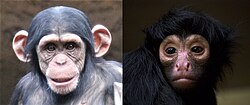| Simian Julat zaman: Pertengahan Eosen-Holosen,
| |
|---|---|

| |
| Seekor catarrhine (cimpanzi biasa) dan seekor platyrrhine (Ateles paniscus) | |
| Pengelasan saintifik | |
| Domain: | Eukaryota |
| Alam: | Haiwan |
| Filum: | Chordata |
| Kelas: | Mammalia |
| Order: | Primates |
| Suborder: | Haplorhini |
| Infraorder: | Simiiformes Haeckel, 1866[1][2] |
| Parvorder | |
| Sinonim | |
|
Antropoid | |
Simian (infraorder Simiiformes) merupakan rumpun monyet dan mawas termasuklah: satu klad monyet Dunia Baru atau platyrrhine (hidung kemik), dan satu klad catarrhine (hidung bengkok) yang terdiri daripada monyet Dunia Lama, mawas dan manusia.
Simian merupakan saudara kepada makhluk tarsier, bersama-sama membentuk rumpun haplorhine (hidung kering). Rumpun Haplorhini ini timbul kira-kira 60 juta tahun dahulu (ketika zaman Senozoik). 40 juta tahun dahulu, makhluk-makhluk simian dari Afrika menduduki Afrika Selatan, melahirkan monyet Dunia Baru. Simian-simian yang tinggal (iaitu catarrhine) berpecah menjadi mawas dan monyet Dunia Lama 25 juta tahun dahulu.
Pengelasan
| Filogeni bagi primat yang masih wujud | |||||||||||||||||||||||||||
| |||||||||||||||||||||||||||
| Kladogram. Untuk setiap klad dinyatakan anggaran kemunculan klad ekstan baru dalam kiraan juta tahun dahulu |
Yang berikut ialah senarai pelbagai keluarga simian dan kedudukan masing-masing dalam order Primates:[1][2]
- Order Primates
- Suborder Strepsirrhini: prosimian bukan tarsier
- Suborder Haplorhini: tarsier + monyet, termasuk mawas
- Infraorder Tarsiiformes
- Infraorder Simiiformes
- Parvorder Platyrrhini: monyet Dunia Baru
- Keluarga Callitrichidae: marmoset dan tamarin
- Keluarga Cebidae: monyet capuchin dan monyet tupai
- Keluarga Aotidae: monyet malam (douroucoulis)
- Keluarga Pitheciidae: titi, saki dan uakari
- Keluarga Atelidae: monyet melolong, monyet labah-labah dan monyet berbulu lebat
- Parvorder Catarrhini
- Superkeluarga Cercopithecoidea
- Keluarga Cercopithecidae: Monyet Dunia Lama
- Superkeluarga Hominoidea
- Keluarga Hylobatidae: ungka
- Keluarga Hominidae: mawas besar dan manusia
- Superkeluarga Cercopithecoidea
- †Amphipithecidae
- †Eosimiidae
- Parvorder Platyrrhini: monyet Dunia Baru
Yang berikut ialah kladogram dengan beberapa spesies simian yang pupus dengan spesies-spesies yang lebih moden muncul dalam kalangan Eosimiidae. Simian berasal dari Asia sementara crown simian berada di Afrika-Arab.[3][4][5][6][7] Dinyatakan masa klad berpecah menjadi klad-klad baharu dalam kiraan juta tahun dahulu (jtd).
| Haplorhini (64) |
| |||||||||||||||||||||||||||||||||||||||||||||||||||||||||||||||||||||||||||||||||||||||||||||||||||||||||||||||||||||
Biasanya, Ekgmowechashalidae dikira sebagai Strepsirrhini dan bukanlah Haplorhini.[8] Sebuah kajian pada 2018 meletakkan Eosimiidae sebagai saudara kepada crown haplorhini.[9]
Rujukan
- ^ a b Groves, Colin (16 November 2005). Wilson, D. E., dan Reeder, D. M. (ed.) (penyunting). Mammal Species of the World (ed. ke-3). Percetakan Universiti Johns Hopkins. m/s. {{{pages}}}. ISBN 0-801-88221-4.CS1 maint: multiple names: editors list (link) CS1 maint: extra text: editors list (link)
- ^ a b Rylands AB, Mittermeier RA (2009). "The Diversity of the New World Primates (Platyrrhini)". Dalam Garber PA, Estrada A, Bicca-Marques JC, Heymann EW, Strier KB (penyunting). South American Primates: Comparative Perspectives in the Study of Behavior, Ecology, and Conservation. Springer. ISBN 978-0-387-78704-6. Unknown parameter
|lastauthoramp=ignored (bantuan) - ^ Marivaux, Laurent; Antoine, Pierre-Olivier; Baqri, Syed Rafiqul Hassan; Benammi, Mouloud; Chaimanee, Yaowalak; Crochet, Jean-Yves; Franceschi, Dario de; Iqbal, Nayyer; Jaeger, Jean-Jacques (2005-06-14). "Anthropoid primates from the Oligocene of Pakistan (Bugti Hills): Data on early anthropoid evolution and biogeography". Proceedings of the National Academy of Sciences of the United States of America (dalam bahasa Inggeris). 102 (24): 8436–8441. doi:10.1073/pnas.0503469102. ISSN 0027-8424. PMC 1150860. PMID 15937103.
- ^ Seiffert, Erik R.; Boyer, Doug M.; Fleagle, John G.; Gunnell, Gregg F.; Heesy, Christopher P.; Perry, Jonathan M. G.; Sallam, Hesham M. (2017-04-10). "New adapiform primate fossils from the late Eocene of Egypt". Historical Biology. 0 (1–2): 204–226. doi:10.1080/08912963.2017.1306522. ISSN 0891-2963.
- ^ Cartmill, M.; Smith, F. H (2011). The Human Lineage. John Wiley & Sons. ISBN 978-1-118-21145-8.
- ^ Ryan, Timothy M.; Silcox, Mary T.; Walker, Alan; Mao, Xianyun; Begun, David R.; Benefit, Brenda R.; Gingerich, Philip D.; Köhler, Meike; Kordos, László (2012-09-07). "Evolution of locomotion in Anthropoidea: the semicircular canal evidence". Proceedings of the Royal Society of London B: Biological Sciences (dalam bahasa Inggeris). 279 (1742): 3467–3475. doi:10.1098/rspb.2012.0939. ISSN 0962-8452. PMC 3396915. PMID 22696520.
- ^ Hartwig, W. (2011). "Chapter 3: Primate evolution". Dalam Campbell, C. J.; Fuentes, A.; MacKinnon, K. C.; Bearder, S. K.; Stumpf, R. M (penyunting). Primates in Perspective (ed. 2nd). Oxford University Press. m/s. 19–31. ISBN 978-0-19-539043-8.CS1 maint: ref=harv (link)
- ^ Ni, Xijun; Li, Qiang; Li, Lüzhou; Beard, K. Christopher (2016-05-06). "Oligocene primates from China reveal divergence between African and Asian primate evolution". Science (dalam bahasa Inggeris). 352 (6286): 673–677. doi:10.1126/science.aaf2107. ISSN 0036-8075. PMID 27151861.
- ^ Holroyd, Patricia A.; Silcox, Mary T.; López-Torres, Sergi (2018-09-22). "New omomyoids (Euprimates, Mammalia) from the late Uintan of southern California, USA, and the question of the extinction of the Paromomyidae (Plesiadapiformes, Primates)". Palaeontologia Electronica (dalam bahasa English). 21 (3): 1–28. doi:10.26879/756. ISSN 1094-8074.CS1 maint: unrecognized language (link)








